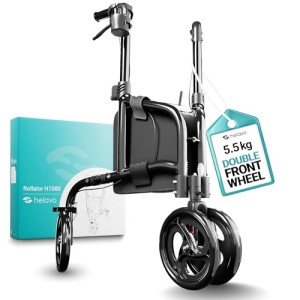Who Is Responsible For The Four Wheel Walker Budget? 12 Best Ways To Spend Your Money
Understanding the Four-Wheel Walker: A Comprehensive Guide
As people age or face health obstacles, mobility can end up being a considerable concern. The four-wheel walker— also called a rollator— is created to help those who require support while walking. This guide will explore the benefits, features, and types of four-wheel walkers, supplying crucial information for people, caretakers, and healthcare experts.
What is a Four-Wheel Walker?
A four-wheel walker is a mobility aid that features four wheels, hand brakes, a seat, and frequently a storage compartment. Unlike traditional walkers that require users to raise them with each action, four-wheel walkers permit smooth movement and offer additional support for people who might have problem with balance or endurance while walking.
Secret Features of a Four-Wheel Walker
Feature
Description
Wheels
Typically features four wheels for improved mobility.
Brakes
Hand-operated brakes for added control and security.
Seat
A built-in seat permits users to rest when required.
Storage
Typically consists of a storage pouch or basket for individual items.
Height Adjustability
Can be adjusted to fit the user's height for comfort and ease of usage.
Advantages of Using a Four-Wheel Walker
1. Improved Mobility
Among the primary advantages of a four-wheel walker is the increased mobility it provides. Users can navigate through indoor and outdoor areas easily, thanks to the rolling wheels. This mobility motivates exercise, which is essential for keeping overall health.
2. Security and Stability
Four-wheel walkers come equipped with durable frames and reliable braking systems. This design promotes safety, particularly for people with balance problems, guaranteeing they feel secure while walking.
3. Convenience Features
With the addition of a seat and ergonomic handles, four-wheel walkers offer comfort during use. Users can take breaks whenever necessary, which is especially advantageous for those who tire easily.
4. Adaptability
These walkers can be used in numerous settings, including at home, in public spaces, and outdoors. Numerous designs are created to be lightweight and foldable, making them easy to transport.
Types of Four-Wheel Walkers
Not all four-wheel walkers are created equal, and several variations deal with specific needs and choices. Below is a list of different kinds of four-wheel walkers:
1. Requirement Rollators
Requirement rollators are the most common type, including standard designs with four wheels, hand brakes, and a seat. They appropriate for daily usage, providing vital support for walking.
2. Heavy-Duty Rollators
These walkers are developed for users with higher weight-bearing requirements. Heavy-duty rollators have strengthened frames and wider seats, accommodating bigger individuals while offering the exact same mobility and support.
3. Lightweight Rollators
Ideal for those who take a trip often, lightweight rollators are compact and easily foldable. They are convenient for transport and are generally simpler for users to maneuver.
4. Rollators with Specialized Features
Some rollators include distinct features, such as integrated LED lights for night use, baskets developed for bring bigger products, or enhanced suspension systems for improved convenience on irregular surface areas.
How to Choose the Right Four-Wheel Walker
Selecting the best four-wheel walker requires consideration of numerous aspects. Here's a list to assist you:
1. User's Weight and Height
- Guarantee the walker can support the user's weight.
- Choose an adjustable model that accommodates the user's height for comfortable use.
2. Planned Use
- Consider where the walker will primarily be utilized: inside, outdoors, or both.
- Try to find designs with larger wheels for better performance on outdoor terrains.
3. Comfort Features
- Examine the seat height and convenience level.
- Examine for extra features, such as padded manages, for enhanced usability.
4. Storage Needs
- Figure out if the user requires a storage pouch or basket for carrying personal belongings.
5. Budget plan
- Assess the costs, keeping in mind that rates can range commonly depending on the features and brand.
Often Asked Questions (FAQ)
Q1: Are four-wheel walkers appropriate for any ages?
A: While the majority of frequently used by older grownups, four-wheel walkers can benefit people of any ages who have mobility challenges due to injury, surgical treatment, or health conditions.
Q2: How do you maintain a four-wheel walker?
A: Regularly examine the wheels for debris, guarantee the brakes function correctly, and sometimes clean the walker with moderate soap and water to keep it in excellent working order.
Q3: Can I use a four-wheel walker outdoors?
A: Yes, many four-wheel walkers are developed for both indoor and outdoor use. However, selecting a model with larger, durable wheels is recommended for irregular surface areas.
Q4: Do insurance strategies cover the cost of four-wheel walkers?
A: Coverage varies by insurance coverage plan. It's best to talk to your provider regarding protection for mobility aids.
Q5: How do I find out to utilize a four-wheel walker effectively?
A: It may be useful to deal with a physiotherapist or healthcare professional to learn how to use a four-wheel walker securely and successfully.
Four-wheel walkers serve as important mobility help for those who require extra support while walking. By comprehending Non-Slip Walker , advantages, and types, users and caregivers can choose the ideal design to enhance mobility and preserve self-reliance. As mobility difficulties emerge, it's soothing to know that tools like four-wheel walkers can considerably enhance lifestyle and promote a more active way of life.
